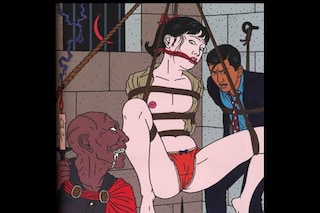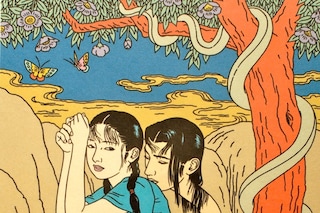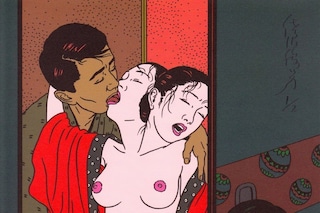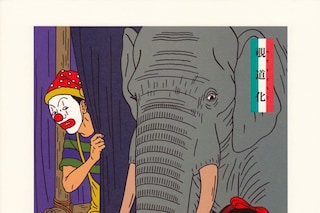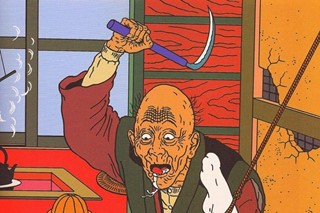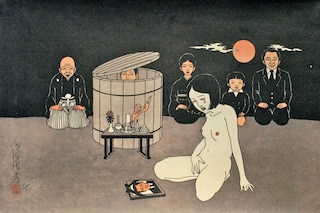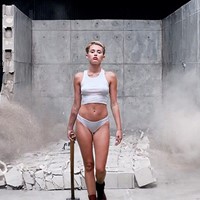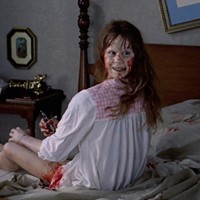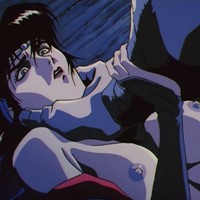The ultra-violent Japanese artist on his sick beauty
Toshio Saeki was born in Miyazaki, Japan and was raised in Osaka. Aged 24, he moved to Tokyo, at a time when the sex industry was exploding. Saeki quit a day job at an advertising agency after a few months, and wound up contributing to Japanese cult men's magazine Heibon Punch, who 'showed women how to pose to provoke their boyfriends'. It was his work for HP in the 60s and 70s that would pique the interest of the contemporary scene: worldwide exhibitions followed and his work received international acclaim.
Saeki's extreme, intensely controversial images relate simultaneously to modern and ancient art practices. The provocative tendencies of the artist's crazy mind are, for example, inspired by childhood nightmares, scenes from his everyday life imprinted on his photographic memory, the stars of 'Ginei' movies and Western comics. At the same time, Saeki addresses medieval Japanese art - known as 'ukiyo-e - with his 'Chinto' method of printing, according to which the Eshi (artist) and the Surishi (printer) share a unique rapport.
Saeki's creations began as entertainment for his school friends, and they entertain still with their disturbing charm, a kind of erotic horror show. The artist meanwhile is now approaching 70 years, living somewhere in the Japanese wilderness.
(Full disclosure – the art gallery I help run, NO WAY are happily producing the first ever UK show of Saeki's work, at London's Print House Gallery in March, thanks to Ghostown, who open his first show inside Israel in Tel Aviv this week.)
Why does violence feature so prominently in your work?
Toshio Saeki: Let me put it this way: leave other people to draw seemingly beautiful flowers that bloom within a nice, pleasant-looking scenery. I try instead to capture the vivid flowers that sometimes hide and sometimes grow within a shameless, immoral and horrifying dream.
The works are at times frightening, while at other moments they contain humour. Where does this come from?
Toshio Saeki: I’ve always been attracted to scary and paranormal things because they are mysterious. I love enigma and things that aren’t easy to understand. As for humour, I grew up in Osaka which is to the west of Tokyo, where people value sense of humour and everyday conversation is full of jokes, so maybe I get that from there. But the humour in my work is not intentional. I never realised that aspect existed within it, until someone pointed it out to me.
There is a recuring motif in your work of physical sickness – portraying diseased and decaying characters, often engaging in extreme sexual acts – why is this?
Toshio Saeki: I had a sickly father and as a child, and, since we did not live in a big house, I often saw him being examined by a doctor at home. I was scared and worried, but at the same time, very curious. Perhaps my inspirations come from this kind of experience in my childhood.
Women are often bound with ropes in your work – what effect do you feel this has?
Toshio Saeki: In my life, I’ve done lots of work drawing images for magazines and books. And I’ve done lots of work for S&M magazines so that’s probably the reason that there are many images of women bound with ropes. But that might not be the only reason. I have a strong proclivity towards finding universal truths in things that are looked at with disrespect and treated coldly, or driven away from society. And it’s true that all sorts of vulgar and indecent aspects of sub-culture expanded the scale of my works.
Though your images often depict extremely violent acts – mutilation of genitalia and so forth – the characters experiencing them, both men and women, however, do not often seem to show pain – do you see the figures as consenting?
Toshio Saeki: Let’s not forget that the images I draw are fictional. Depicting the character’s faces without pain or suffering brings out the effect of the “unusual and extraordinary.” Whether or not the figures are consenting or not does not really matter to me.
Do you work from imagination or do you have models pose for you?
Toshio Saeki: All of it comes from my imagination, although sometimes I use photos or references to check the details like patterns on the lining of a kimono, etc. But overall the picture is all from my head. Since I was a child, I think that I was always keeping a stock of memorable images. When working on a new drawing, I wait until the appropriate images from my stock falls out in a natural way.
You often draw an onlooker or observer into the scene. The conscious surfacing in the subconscious?
Toshio Saeki: I think that your interpretation is not wrong. The appearance of a third person makes the scene more dramatic, whether one likes it or not. By having an onlooker peeping at a secret act, that gives the scene more meaning, and makes the picture more fun.
One of my favourite works is the image of a woman slicing her breast into a kneeling man’s mouth – can you talk a little about this image?
Toshio Saeki: I only explain myself through my drawings, I can’t put into words what the images mean. It would not be difficult for me to come up with various arguments concerning the images, but that will distort the understanding of the works for sure. Your sensitivity that you find this work to be your favorite is the most truthful and accurate view of it.
How do you feel about the appropriation of your images, and about the responses it elicits from women's groups
Toshio Saeki: Recently, many women come to see my exhibits; I think this shows that people are starting to understand that my works do not encourage violence to the observers. On the other hand, I've never wished to draw anything that would be favored by all people, and I try to capture people's attention through horrifying visuals and terrifying illusions, so I'm aware that antipathy from a certain group of people or society in general is unavoidable. As for people using my work, that's not a problem concerning just my work, and if there's any way to prevent it, I'd really like to be informed.
Interview by Charlotte Jansen & Maki Hakui
An exhibition of works by Toshio Saeki will take place at Dalston’s The Print House Gallery, from 28th March 2013 for six weeks. It is part of a two-city collaboration between NO WAY (London) and Ghostown crew (Tel Aviv).
Ghostowncrew.com
No-way.org.uk

